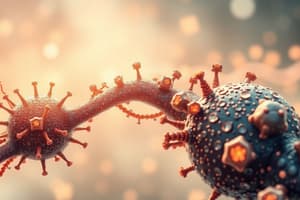Podcast
Questions and Answers
What is the primary function of cell signaling?
What is the primary function of cell signaling?
- To facilitate cellular communication and response to the environment (correct)
- To maintain cellular structure
- To synthesize proteins
- To regulate gene expression
What type of cell signaling involves cells producing signals that affect neighboring cells?
What type of cell signaling involves cells producing signals that affect neighboring cells?
- Paracrine signaling (correct)
- Juxtacrine signaling
- Endocrine signaling
- Autocrine signaling
What is the function of a receptor in cell signaling?
What is the function of a receptor in cell signaling?
- To activate downstream signaling molecules
- To transmit signals through the bloodstream
- To bind to signaling molecules, initiating a response (correct)
- To produce signaling molecules
What is the second step of the cell signaling process?
What is the second step of the cell signaling process?
What is the mechanism of cell signaling that involves a series of phosphorylation reactions?
What is the mechanism of cell signaling that involves a series of phosphorylation reactions?
What is the importance of cell signaling in development and tissue repair?
What is the importance of cell signaling in development and tissue repair?
What type of cell signaling involves cells producing signals that are transported through the bloodstream to affect distant cells?
What type of cell signaling involves cells producing signals that are transported through the bloodstream to affect distant cells?
What is the result of signal response in cell signaling?
What is the result of signal response in cell signaling?
Flashcards are hidden until you start studying
Study Notes
Cell Signaling
Definition
- Cell signaling is the process by which cells communicate with each other and respond to their environment.
- It involves the transmission, reception, and response to signals, allowing cells to coordinate their behavior and adapt to changes.
Types of Cell Signaling
- Autocrine signaling: cells produce and respond to their own signals.
- Paracrine signaling: cells produce signals that affect neighboring cells.
- Endocrine signaling: cells produce signals that are transported through the bloodstream to affect distant cells.
- Juxtacrine signaling: cells produce signals that affect adjacent cells through direct contact.
Components of Cell Signaling
- Signaling molecule (ligand): a molecule that binds to a receptor, triggering a response.
- Receptor: a protein that binds to a signaling molecule, initiating a response.
- Signal transduction pathway: a series of molecular interactions that transmit the signal from the receptor to the target molecule.
Steps of Cell Signaling
- Signal reception: the ligand binds to the receptor.
- Signal transduction: the signal is transmitted through the signal transduction pathway.
- Signal response: the target molecule is activated or inhibited, leading to a cellular response.
Mechanisms of Cell Signaling
- Binding of ligand to receptor: the ligand binds to the receptor, causing a conformational change.
- Activation of G-proteins: G-proteins are activated, leading to the activation of downstream signaling molecules.
- Phosphorylation cascade: a series of phosphorylation reactions that activate or inhibit downstream signaling molecules.
Importance of Cell Signaling
- Regulation of cellular processes: cell signaling regulates various cellular processes, including metabolism, growth, and differentiation.
- Development and tissue repair: cell signaling is essential for development, tissue repair, and regeneration.
- Disease and disorder: disruptions in cell signaling can lead to various diseases and disorders, such as cancer and developmental disorders.
Cell Signaling
Definition
- Cell signaling enables cells to communicate with each other and respond to their environment, allowing for coordination of behavior and adaptation to changes.
Types of Cell Signaling
- Autocrine signaling: cells respond to their own signals, influencing their own behavior.
- Paracrine signaling: cells produce signals that affect neighboring cells, enabling local communication.
- Endocrine signaling: cells produce signals that travel through the bloodstream to affect distant cells, enabling systemic communication.
- Juxtacrine signaling: cells produce signals that affect adjacent cells through direct contact, facilitating local communication.
Components of Cell Signaling
- Signaling molecule (ligand): a molecule that binds to a receptor, triggering a response.
- Receptor: a protein that binds to a signaling molecule, initiating a response.
- Signal transduction pathway: a series of molecular interactions that transmit the signal from the receptor to the target molecule.
Steps of Cell Signaling
Signal Reception
- Ligand binds to the receptor, initiating a response.
Signal Transduction
- The signal is transmitted through the signal transduction pathway.
Signal Response
- The target molecule is activated or inhibited, leading to a cellular response.
Mechanisms of Cell Signaling
- Ligand binds to receptor, causing a conformational change that triggers a response.
- Activation of G-proteins leads to the activation of downstream signaling molecules.
- Phosphorylation cascade: a series of phosphorylation reactions that activate or inhibit downstream signaling molecules.
Importance of Cell Signaling
Regulation of Cellular Processes
- Cell signaling regulates various cellular processes, including metabolism, growth, and differentiation.
Development and Tissue Repair
- Cell signaling is essential for development, tissue repair, and regeneration.
Disease and Disorder
- Disruptions in cell signaling can lead to various diseases and disorders, such as cancer and developmental disorders.
Studying That Suits You
Use AI to generate personalized quizzes and flashcards to suit your learning preferences.




